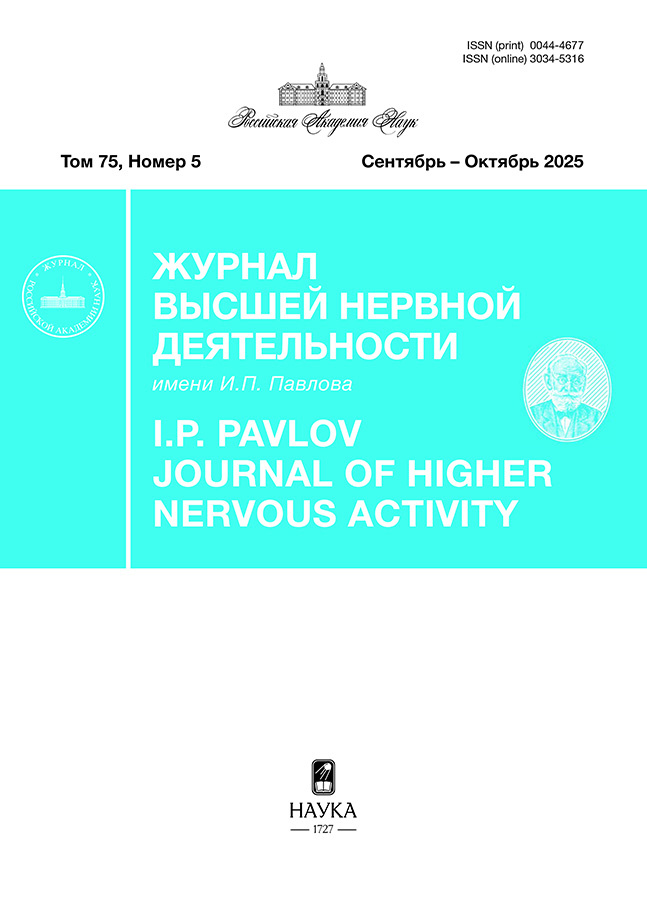Том 74, № 5 (2024)
ОБЗОРЫ И ТЕОРЕТИЧЕСКИЕ СТАТЬИ
Представление пространственной информации в поле СА1
Аннотация
Информация в мозге кодируется большими популяциями нейронов – нейронными ансамблями. Клетки места в поле СА1 гиппокампа стали экспериментальной моделью изучения нейронных ансамблей мозга в силу удобства исследования. Этот обзор посвящен последним исследованиям клеток места в поле СА1. Мы рассматриваем принципы кодирования пространства клетками места, механизмы контроля активности клеток места, анатомические и физиологические особенности клеток места в разных частях поля СА1. Ключевые выводы: 1) Существует частотное и фазовое кодирование; 2) Плотные локальные связи между пирамидными нейронами могут обеспечивать обработку информации; 3) Интернейроны участвуют в формировании как частотного, так и фазового кода клеток места; 4) Пирамидные нейроны анатомически и функционально подразделяются на глубокие и поверхностные; 5) Вдоль дорсовентральной оси происходит обобщение пространственного и непространственного компонента информации. Поле СА1 имеет широкие возможности для обработки сигналов и может реализовать вычислительно сложную операцию в когнитивных процессах мозга.
 517-537
517-537


О механизмах патогенеза болезни Альцгеймера: особая роль переднебазального мозга
Аннотация
Болезнь Альцгеймера (БА) – прогрессирующее нейродегенеративное заболевание, характеризующееся измененным поведением и нарушением когнитивных функций, от незначительных их отклонений до деменции. Типичным для этой болезни является наличие в мозге сенильных бляшек, нейрофибриллярных клубков, повреждение синапсов и потеря нейронов. Многие факторы способствуют ослаблению когнитивных способностей у пациентов с БА. По холинергической гипотезе, преобладающей в конце прошлого века и сохраняющей свою актуальность в настоящее время, ключевым событием в патогенезе БА является потеря холинергических нейронов в переднебазальном мозге (ПБМ), обнаруженная в этой области у пациентов с БА. Однако гибель нейронов ПБМ лишает мозг целого набора других нейрохимических агентов. Кроме того, возникновение БА, очевидно, обусловлено также иными морфофункциональными отклонениями в этой области мозга. В современной литературе отсутствуют суммарные сведения о роли ПБМ в патогенезе БА. Функции ПБМ и механизмы регуляции нейронной сети этого отдела мозга в норме и при нейропатологиях остаются неясными. В настоящем обзоре всесторонне рассматривается участие ПБМ и его связей с другими областями мозга в развитии БА. В статью включены данные клинических наблюдений и экспериментов, проведенных как на здоровых животных, так и на животных с моделями этого заболевания. Проведенный анализ имеющихся литературных данных улучшит понимание функционирования ПБМ в норме и его нарушений при развитии БА, что может продвинуть разработку терапевтических подходов для лечения этой болезни.
 538-564
538-564


Центральные нейробиологические механизмы стрессоустойчивости при посттравматическом стрессовом состоянии
Аннотация
Посттравматическое стрессовое расстройство (ПТСР) – это тяжелый, инвалидизирующий синдром, который индуцируется экстремальным негативным воздействием на психику людей. Симптомы заболевания чаще всего проявляются не у всей популяции стрессированных и не сразу, а через некоторый неопределенный период времени. Заболевание обусловлено центральными генетическими, эпигенетическими и нейробиологическими детерминантами, интегрированными в основу социального и природно-антропогенного контекста. Установлено одновременное развитие патологической реакции со стороны гипоталамо-гипофизарно-адреналовой, симпатоадреналовой и иммунной систем. Рассмотрено состояние основных биогенных и аминокислотных нейромедиаторов ЦНС при ПТСР. В настоящее время внимание исследователей сосредоточено на таких пептидных гормонах, как нейротрофический фактор головного мозга, нейропептид Y и лептин, которые могут быть использованы для диагностики и лечения ПТСР. Анализ литературы позволил сделать вывод, что об особенностях стрессоустойчивости людей и животных известно пока очень мало.
 565-590
565-590


ФИЗИОЛОГИЯ ВЫСШЕЙ НЕРВНОЙ (КОГНИТИВНОЙ) ДЕЯТЕЛЬНОСТИ ЧЕЛОВЕКА
Активность мышц нижних конечностей... В условиях управления нейроинтерфейсом: нейроинтерфейс, основанный на воображении ходьбы
Аннотация
При реабилитации двигательных нарушений с использованием нейроинтерфейсов существенен вопрос об активности мышц, которые обеспечивают реализацию воображаемого движения. Сведения в литературе об этом противоречивы. В работе проведен анализ ЭМГ-активности мышц голени и бедра 40 здоровых добровольцев при работе с нейроинтерфейсом, основанным на кинестетическом воображении ходьбы на месте и дополненным робототехническим устройством перемещения конечностей «Биокин» (механотерапия), активируемым в случае успешного воображения движений. Показано, что работа с нейроинтерфейсом в среднем по всем участникам эксперимента приводит к увеличению активности мышц при воображении ходьбы по сравнению с покоем, а активация механотренажера (АМ) дополнительно увеличивает мышечную активность, причем ее влияние в большей степени выражено в мышцах той ноги, с которой начинается воображение ходьбы. Характер реакций мышц на задачу воображения ходьбы индивидуален. С АМ при работе с нейроинтерфейсом количество участников эксперимента с выраженной ЭМГ-активностью увеличивается, как и количество значимых корреляционных связей между активностью мышц нижних конечностей. Таким образом, использование нейроинтерфейсов, основанных на воображении ходьбы, и АМ в качестве обратной связи позволяет активизировать мышцы нижних конечностей, что важно в клинической практике при реабилитации движений.
 591-605
591-605


Локальные полевые потенциалы и активность нейронов в моторных сетях при леводопа-индуцированной дискинезии на модели болезни Паркинсона
Аннотация
Леводопа, метаболический предшественник дофамина (ДА), используется для устранения двигательных нарушений при болезни Паркинсона (БП). Длительное применение леводопы вызывает серьезный побочный эффект, известный как леводопа-индуцированная дискинезия (ЛИД). При развитии ЛИД в записях локальных полевых потенциалов (ЛПП) моторной коры (МСх) y крыс с экспериментальной БП и у пациентов с болезнью Паркинсона регистрируются высокочастотные гамма-осцилляции (~100 Гц). Механизмы, лежащие в основе возникновения этих осцилляций, и их связь с ЛИД до конца не ясны. Изучение нейронной активности в отделах моторной сети может дать важную информацию о механизмах развития патологических гамма-осцилляций и ЛИД. Крысам с экспериментальной БП вводили леводопy в течение 7 дней. Локальныe полeвыe потенциалы (ЛПП) и нейронную активность регистрировали с электродов, имплантированных в моторную кору, вентромедиальное ядро таламуса (Vm) и сетчатую часть черной субстанции (SNpr). Дискинезию оценивали по стандартной шкале аномальных непроизвольных движений. Введение леводопы значительно снижало мощность бета-осцилляций (30–36 Гц) во всех 3 отделах моторной нейросети, связанных с брадикинезией при БП, и вызывало появление когерентных осцилляций в гамма-диапазоне ЛПП в Vm и MCx. Их когерентность возрастала к 7-му дню введения леводопы. Эта активность тесно связана с возникновением дискинезии. При ЛИД увеличение частоты нейроннoй активности в Vm и MCx сопровождалось усилением ее синхронизации c кортикальными гамма-осцилляциями в Vm (68%) и MCx (25%). В отличие от Vm и MCx, в SNpr при ЛИД не наблюдалась осцилляторная активность в гамма-диапазоне, и его нейронная активность не была синхронизована с ЛПП в Vm и MCx. Существенно, что в период ЛИД частота спайковой активности SNpr в большинстве записей (76%) значительно снижалась и была примерно в три раза ниже исходнoй (до введения леводопы). Введение антидискинетического препарата, 8-OH-DPAT, восстанавливало исходные характеристики ЛПП (30–36 Гц осцилляции), нейронной активности и брадикинезию. Таким образом, многократное введение леводопы приводит к снижению тормозного контроля в моторныx нейросетях за счет значительного уменьшения активности нейронов SNpr. Очевидно, что Vm и SNpr можно рассматривать как важнейшие компоненты моторной нейросети, вносящие основной вклад в возникновение высокочастотных гамма-осцилляций и ЛИД.
 606-620
606-620


ФИЗИОЛОГИЧЕСКИЕ МЕХАНИЗМЫ ПОВЕДЕНИЯ ЖИВОТНЫХ: ВОСПРИЯТИЕ ВНЕШНИХ СТИМУЛОВ, ДВИГАТЕЛЬНАЯ АКТИВНОСТЬ, ОБУЧЕНИЕ И ПАМЯТЬ
Влияние обогащенной среды на обучение и память в водном лабиринте Морриса у крыс с острым и хроническим провоспалительным стрессом
Аннотация
Известно, что содержание животных в обогащенной среде (ОС) предотвращает развитие тревожно-депрессивных расстройств и когнитивных нарушений, вызванных разными стрессами. В очень ограниченном числе работ по исследованию обучения и памяти в водном лабиринте Морриса животные подвергались провоспалительному стрессу (ПВС) до влияния ОС. В настоящей работе мы впервые исследовали обратную последовательность взаимодействия ОС и стресса, когда животные сначала содержались в ОС, а потом уже подвергались ПВС. С этой целью 40 крыс в возрасте от 25 до 45 дней помещали в ОС, а 40 других крыс содержали в стандартных условиях. ПВС у крыс обеих групп вызывали введением либо 350 мкг/кг бактериального липополисахарида (ЛПС) однократно (острый стресс) или 200 мкг/кг многократно (хронический) за 1 час до начала поведенческих тестов и по ходу их проведения. Контрольным животным вводили физраствор в том же объеме. Полученные данные свидетельствуют, что крысы, содержавшиеся в ОС, быстрее находили скрытую под водой платформу и проплывали до нее меньшее расстояние, чем крысы, которых содержали в стандартных условиях. У животных с острым и хроническим ЛПС-стрессом предварительное содержание в условиях ОС приводило к нормализации показателей поведения до наблюдаемых у контрольных крыс. Под влиянием ОС у тех же крыс происходило также улучшение показателей поведения при оценке рабочей памяти. Полученные результаты свидетельствуют о важной роли ОС в благотворном влиянии на поведение крыс при поиске безопасной платформы.
 621-631
621-631


Интервальное ингаляционное применение кислородно-гелиевой смеси устраняет последствия церебральной артериальной воздушной эмболии у крыс
Аннотация
Кислородно-гелиевая смесь демонстрирует выраженную эффективность на животных моделях ишемии/реперфузии, что открывает возможность использования гелиевых смесей в качестве экстренной меры для терапии сосудистой эмболии. Нами была смоделирована церебральная артериальная воздушная эмболия путем введения пузырька воздуха во внутреннюю сонную артерию бодрствующим крысам. Ингаляция подогретой кислородно-гелиевой смеси в первый час после моделирования артериальной эмболии нормализует физиологические отклонения и предупреждает ишемические повреждения головного мозга, в то время как применение подогретой кислородно-гелиевой смеси через 2 часа после моделирования артериальной эмболии значительно ухудшает состояние животных.
 632-637
632-637













